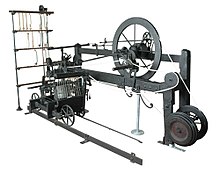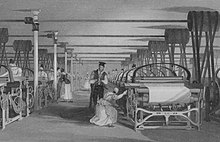Textile manufacture during the British Industrial Revolution
Textile manufacture during the British Industrial Revolution was centred in south Lancashire and the towns on both sides of the Pennines in the United Kingdom.Railroads, steamboats, the telegraph and other innovations massively increased worker productivity and raised standards of living by greatly reducing time spent during travel, transportation and communications.The scale of production in the mill towns round Manchester created a need for a commercial structure; for a cotton exchange and warehousing.Later inventions such as the power loom and Richard Trevithick's high pressure steam engine were also important in the growing industrialisation of Britain.A typical weaving family would own one handloom, which would be operated by the man with help of a boy; the wife, girls and other women could make sufficient yarn for that loom.By the 1820s, all cotton, wool, and worsted was spun in mills; but this yarn went to outworking weavers who continued to work in their own homes.During the second half of the 17th century, the newly established factories of the East India Company in South Asia started to produce finished cotton goods in quantity for the British market.The imported Calico and chintz garments competed with, and acted as a substitute for Indian wool and the linen produce, resulting in local weavers, spinners, dyers, shepherds and farmers petitioning their MPs and in turn Parliament for a ban on the importation, and later the sale of woven cotton goods.[citation needed] The exemption of raw cotton saw two thousand bales of cotton being imported annually, from Asia and the Americas, and forming the basis of a new indigenous industry, initially producing Fustian for the domestic market, though more importantly triggering the development of a series of mechanised spinning and weaving technologies, to process the material.Ports on the west coast of Britain, such as Liverpool, Bristol, and Glasgow, became important in determining the sites of the cotton industry.This invention had two important consequences: it improved the quality of the thread, which meant that the cotton industry was no longer dependent on wool or linen to make the warp, and it took spinning away from the artisans' homes to specific locations where fast-flowing streams could provide the water power needed to drive the larger machines.[8] Resistance by workers to the perceived threat to jobs delayed the widespread introduction of this technology, even though the higher rate of production generated an increased demand for spun cotton.In 1738, Lewis Paul (one of the community of Huguenot weavers that had been driven out of France in a wave of religious persecution) settled in Birmingham and with John Wyatt, of that town, they patented the Roller Spinning machine and the flyer-and-bobbin system, for drawing wool to a more even thickness.1743: A factory opened in Northampton, fifty spindles turned on five of Paul and Wyatt's machines proving more successful than their first mill.Lewis's invention was later developed and improved by Richard Arkwright and Samuel Crompton, although this came about under great suspicion after a fire at Daniel Bourn's factory in Leominster which specifically used Paul and Wyatt's spindles.[12] An improvement devised by Joshua Wrigley, trialled in Chorlton-upon-Medlock used two Savery engines to supplement the river in driving on overshot waterwheel.Others such as Robert Grimshaw (whose factory was destroyed in 1790 as part of the growing reaction against the mechanization of the industry) and Austin[14] – developed the ideas further.In 1803, William Radcliffe invented the dressing frame which was patented under the name of Thomas Johnson which enabled power looms to operate continuously.With the Cartwright Loom, the Spinning Mule and the Boulton & Watt steam engine, the pieces were in place to build a mechanised textile industry.Developments in the transport infrastructure - the canals and, after 1831, the railways - facilitated the import of raw materials and export of finished cloth.For example, Samuel Greg joined his uncle's firm of textile merchants, and, on taking over the company in 1782, he sought out a site to establish a mill.It was the mainstay of the Lancashire cotton industry for a century, when the Northrop Loom invented in 1894 with an automatic weft replenishment function gained ascendancy.[17][18] The draw while spinning had been assisted by power, but the push of the wind had been done manually by the spinner, the mule could be operated by semiskilled labour.The work-discipline was forcefully instilled upon the workforce by the factory owners, and he found that the working conditions were poor, and poverty levels were at an unprecedented high.About half of workers in Manchester and Stockport cotton factories surveyed in 1818 and 1819 had begun work at under ten years of age.Later, the minimum age was raised to 10 and the children were given 6 hours of education a week, so that they could do the record keeping their illiterate parents could not.In 1779, Arkwright installed a cannon, loaded with grapeshot, just inside the factory gate,[28] as a warning to would-be rioting textile workers, who had burned down another of his mills in Birkacre, Lancashire.[33] The structure was good and it successfully converted to ring spinning in 1920- and was the first mill to adopt mains electricity as its principal source of power.[36][37] Following the creation of the United States, an engineer who had worked as an apprentice to Arkwright's partner Jedediah Strutt evaded the ban.In 1789, Samuel Slater took his skills in designing and constructing factories to New England, and he was soon engaged in reproducing the textile mills that helped America with its own industrial revolution.







BarmenWupper ValleyAugust von WilleLancashirePenninesIndustrial Revolutiontextile manufacturingiron foundingsteam powerpremises in which they livedpackhorsesriver navigationscanalsartisanscottoncardingspinningcast ironspinning muleswater framesstreamsbeam enginesrotative mill enginesline shaftspower loomsweaving shedsmill townscommercial structurecotton exchangewarehousingwoollenworstedWest YorkshireJohn Kay'sflying shuttleRichard Arkwrightwater frameSpinning JennySpinning Mulecotton millssteam engineJames WattwaterpowerIron industrysmeltingcharcoalcopperpig ironblast furnacebar ironpotting and stampingpatentHenry Cortpower loomRichard Trevithickironworkswatermillcottage industryhandloomfustiansimple wheelSaxony wheelspindleJohn Kayweaving shedEast India CompanySouth AsiaCalicochintzParliamentCalico ActsBengalgovernmentprotectionisttariffsplantationsAmerican SouthRevolutionary WarAmerican Civil WarIndian subcontinentLiverpoolBristolGlasgowcotton industryJames HargreavesWestern PenninesSamuel CromptonThomas SaveryThomas NewcomenMatthew BoultonBury, LancashireinventionsLewis PaulHuguenotweaversBirminghamJohn WyattRoller Spinning machineflyer-and-bobbindonkeyNorthamptonLeominsterDuke of Bridgewater's canalWorsleySoho FoundryHandsworthcotton millThorp MillRoytonThomas HighsIndustrial unrestBlackburnCromford MillDerbyshirespinning frameWarringtonpatentedwaterwheelsDerwent Valley Millsconstructed accommodationWatt steam engineBoltonmuslinHall i' th' WoodShudehill MillChorlton-upon-Medlock